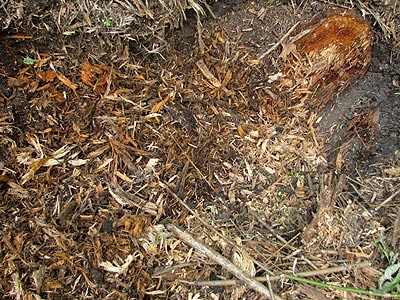RENEGADE GARDENER™
The lone voice of horticultural reason
“You can’t plant a tree in the same spot where you had a tree removed”
A most delicate myth, because in many common scenarios, it’s true. With exceptions.

Aftermath of willow removal, note primary root upper right corner.
Later this summer I may be doing some landscaping for a nice woman who called me following removal of two large, weary willows on the edge of her property. These were massive trees, but willows grow massive in a relatively short amount of time, adding credence to the adage, “Live fast, die young.” It was good to take them out. They were ragged, split, storm-beaten, in decline and ready to crash any year now. Why wait? Get a jump on new trees and, in this case, some additional landscaping.
The tree removal person did a pretty good job of stump grinding, but mentioned that if she has them replaced, she’ll need to plant the new trees at least fifteen feet away from each spot where the willows once stood. Then I show up and tell her different.
Here are the nuances: The reason it’s not a good idea to plant a tree where a tree you had removed once stood is that stump grinding rarely gets all the stump of a large tree. Way down, there might be a little left. And grinding doesn’t get much of the old primary roots out of the way, they’re still there just outside the grinding area. Finally, stump grinding results in a large pile of fresh wood chips mixed with soil. Try to plant a tree there, and as the wood chips start to decompose, they burn all the nitrogen out of the soil. So the new tree, even if a small whip in a container, is trying to grow in contaminated, nitrogen-deprived soil, surrounded by large, old primary roots that take a year to die and twenty years to decompose. Underneath the new tree there may be solid remnants of the old tree stump, polished shiny by the blade from the grinding machine. It’s not a very healthy start.
But what if you remove every bit of the chip-contaminated soil? Further, what if you have the stump removal company (or future landscaper) come in with a big Bobcat with pallet or root forks, and rip out most of the old primary and secondary roots left in the ground, and perhaps the deepest portions of the leftover stump? And then bring in new soil? Can you then plant a tree (or shrubs), where the old tree(s) stood?
Of course you can. If you lose a tree and want to plant another in pretty much the same spot as the old one (due to space restrictions, design, etc.) find a stump grinding service that offers complete stump and root removal, plus will haul out all the contaminated soil—or a landscape company that will take over after the stump grinders have cashed your check.
Don Engebretson
The Renegade Gardener